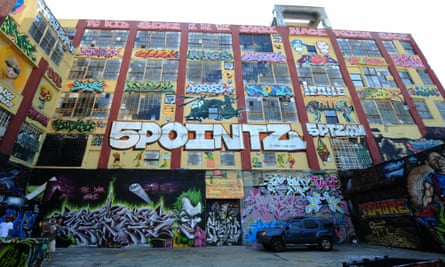A jury has ruled that a real estate developer broke the law by destroying a swath of graffiti art in New York City, in a verdict that could provide legal protections for street artists across the US.
The federal jury made its decision after a group of artists sued Jerry Wolkoff, who painted over their work at the 5Pointz building in Queens, New York City, in November 2013.
5Pointz, a former factory owned by Wolkoff, was a haven for graffiti artists from around the world and became a prominent tourist attraction. Wolkoff had given the artists permission to use the building as a canvas for “aerosol art” and the building was covered in multicolored murals and tags.
But in 2013, when Wolkoff decided to demolish the building and replace it with apartments, he whitewashed the graffiti art in the dead of night.
On Wednesday the jury decided that the artists’ work was legally protected under the Visual Artists Rights Act (Vara), and that meant that Wolkoff had broken the law. It was the first time graffiti, or “aerosol art” had been given that protection under federal law, potentially meaning thousands of graffiti murals across the country could now be preserved.
“It confirms that aerosol art is the same as any other fine artist,” said Eric Baum, the lawyer who represented the 21 artists who sued Wolkoff.
“And that the artist deserves dignity and respect.”

Baum, said a jury had never determined the issue before, and that it could have far-reaching implications.
“It’s a federal statute. So it doesn’t just apply in NY, it applies throughout the country.”
The legal team had to prove the artists’ work was of “recognized stature” – rising to the level of merit under Vara, a 1990 law that affords artists legal protection over their work, irrespective of who owns or holds the copyright to the piece.
In court Baum pointed to the artists’ years of experience and recognition within their field as proof of the merit of their work.
Although the jury’s decision is a boost for the 5Pointz artists, the issue is not yet resolved. The judge in the case will now make his own decision, Baum said, which will take into account the jury’s verdict, but could reach a different conclusion.
A legal precedent – which artists elsewhere could then use to protect their work – will only be set if the judge comes to the same decision as the jury.
In the case Baum pointed to the 5Pointz artists’ years of experience and recognition within their field, but he said even an amateur graffiti artist could potentially have their work protected under the federal statute.
“You could have an expert determine that the work of an amateur rises to the level of merit under Vara that would then provide protection,” he said.
“You’re supposed to look at the artwork. Looking at the artist’s background is only one factor.”

Wolkoff bought the 5Pointz building, which once housed a factory that manufactured water meters, in the 1970s. He gave artists permission to create murals on the building but said he had told them he always intended to demolish it.
In 2013 he finally put those plans into action and drew up plans to raze the building and create an apartment complex. But the way he carried out those plans caused uproar.
On the night of 19 November artists found the building had been almost entirely covered in white paint, blotting out art that had been painstakingly painted over the years.
Kate Lucas, a lawyer with Grossman LLP, which works in the art-law field, said one consequence of the case would be to make graffiti artists – and property owners – aware of the need to set out agreements on ownership and rights to graffiti upfront.
“Graffiti is hot property as art now. And if you’re a property owner who is interested in having graffiti in your courtyard or a mural on your wall or someone who’s going to decorate pieces of your property, the parties can avert a lot of problems by proactively on the front end of the project laying out what their rights and obligations are going to be,” Lucas said.
“And an artist can consider: ‘What’s it worth to me to give up this control over the future of my work?’ Instead of having to put a price on that after the fact, which is what we’re seeing here.”
